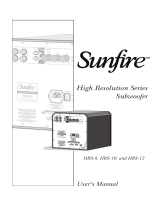
5
www.jbl.com
English
oPeratIng the suBWooFer
TURNING THE SUBWOOFER ON AND OFF
Set the subwoofer’s Power switch to the “On” position. The subwoofer
will automatically turn itself on when it receives an audio signal, and it will
go into Standby mode after it has received no audio signal for 20 minutes.
The subwoofer’s On/Standby LED will glow green when the subwoofer is
on and will glow red when the subwoofer is in Standby.
If you will not be using the subwoofer for an extended period – for
instance, if you’re going on vacation – set the Power switch to the “Off”
position.
SUBWOOFER ADJUSTMENTS: CROSSOVER CONTROL
NOTE: The Crossover control func-
tions only when you are using the Line
In connectors and the Input Mode
switch is set to “Normal.” Setting the
Input Mode switch to “LFE” bypasses
the subwoofer’s built-in crossover and
the Crossover control.
The Crossover control adjusts the
subwoofer’s built-in crossover between 50Hz and 150Hz. The higher
you set the Crossover control, the higher in frequency the subwoofer will
operate and the more its bass will “overlap” that of the satellite speakers.
This adjustment helps achieve a smooth transition of bass frequencies
between the subwoofer and the satellites for a variety of different rooms
and subwoofer locations.
To set the Crossover control, listen for the smoothness of the bass. If the
bass seems too strong at certain frequencies, try a lower Crossover con-
trol setting. If the bass seems too weak at certain frequencies, try a higher
Crossover control setting.
SUBWOOFER ADJUSTMENTS: VOLUME
Use the Level control to set the subwoofer’s
volume. Turn the knob clockwise to increase
the subwoofer’s volume; turn the knob coun-
terclockwise to decrease the volume. Once
you have balanced the subwoofer’s volume
with that of the other speakers in your sys-
tem, you shouldn’t have to change it.
Notes on Setting Subwoofer Volume:
• Sometimes the ideal subwoofer volume setting for music is too loud
for films, while the ideal setting for films is too quiet for music. When
setting the subwoofer volume, listen to both music and films with
strong bass content and find a “middle ground” volume level that
works for both.
• I f your subwoofer always seems too loud or too quiet, you may want
to place it in a different location. Placing the subwoofer in a corner will
tend to increase its bass output, while placing it away from any walls
or corners will tend to lessen its bass output.
SUBWOOFER ADJUSTMENTS: PHASE
The Phase switch determines whether the
subwoofer driver’s piston-like action moves
in and out in phase with the system’s other
speakers. If the subwoofer were to play out
of phase with the other speakers, the sound
waves from the satellites could partially
cancel out the waves from the subwoofer, re-
ducing bass performance and sonic impact.
This phenomenon depends in part on the
placement of all the speakers relative to each other in the room.
Although in most cases you should leave the Phase switch in the “0”
position, there is no absolutely correct setting for the Phase switch. When
the subwoofer is properly in phase with the rest of the system’s speakers,
the sound will be clearer and have maximum impact, and percussive
sounds like drums, piano and plucked strings will sound more lifelike. The
best way to set the Phase switch is to listen to music that you know well
and to set the switch in the position that gives drums and other percussive
sounds maximum impact.
sPecIFIcatIons
Low-frequency
transducer:
10" (250mm) PolyPlas™ cone,
cast basket
Enclosure type: Sealed (forward-firing)
Amplifier power: 300W RMS; 500W peak
Frequency response: 27Hz – 150Hz
Audio controls:
Volume level, crossover frequency,
phase
Connections: RCA line-level and LFE inputs
Power requirement:
120V, 60Hz (US); 220V – 230V,
50Hz/60Hz (EU)
Power consumption:
<6W (120V), <0.55W (230V) standby;
360W – 3.8A (120V) , 395W – 2.1A
(230V) maximum
Dimensions (W x H x D):
17-1/2" x 14-29/32" x 14-31/32"
(444mm x 379mm x 380mm)
Weight: 50 lb (23kg)
© 2011 HARMAN International Industries, Incorporated. All rights reserved.
JBL is a trademark of HARMAN International Industries, Incorporated, registered in the United States and/or other countries.
PolyPlas is a trademark of HARMAN International Industires, Incorporated.
Features, specifications and appearance are subject to change without notice.
HARMAN Consumer, Inc.
8500 Balboa Boulevard, Northridge, CA 91329 USA





